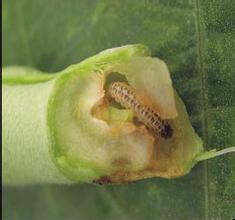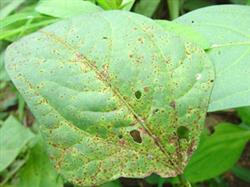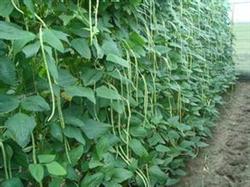Chemical control technology of beans in greenhouse

The cultivation of beans in greenhouse with chemical control technology can regulate the growth and development of plants, increase flowers and protect pods, and increase yield. 1. Control plant type. After emergence, spraying gibberellin with 10 mg / L gibberellin every 5 days for 3 times could make its stem node elongate, branch increase, blossom and pod earlier, and harvest time 3-5 days earlier. Spraying dwarf and paclobutrazol in the middle growth stage of lentil, quarter bean and edamame bean can control plant height, reduce canopy closure and reduce the occurrence of diseases and insect pests. The general concentrations are as follows: 20 mg / L of dwarftin and 150 mg / L of paclobutrazol, and 100 mg / L triiodobenzoic acid can be used to control the plant height and increase the yield of edamame bean. 2. Promote regeneration. In the later growth stage of cowpea and lentil, in order to promote their germination, the seeds can be sprayed with 20 mg / L gibberellin solution, usually once every 5 days and twice. 3. Reduce shedding. The temperature of flowering and podding is too high and too low will increase the drop of flowers and pods of legume vegetables. Spraying 5mg / L naphthylacetic acid or 6mg / L p-chlorophenoxyacetic acid or 12mg / L gibberellin at the flowering stage of string beans and lentils could reduce the flowers and pods of the above-mentioned crops and mature earlier. Due to the increase in the number of pods, it is necessary to apply more fertilizer in order to achieve high yield. 4. Inhibit photorespiration. Photorespiration of crops will consume a lot of assimilating substances, and inhibition of photorespiration of crops can greatly increase crop yield. Sodium bisulfite is an inhibitor of photorespiration in legume crops. It is suitable to use sodium bisulfite from flowering stage to podding stage. If the plant growth is weak, it can be used in advance to the flowering stage. The concentration of sodium bisulfite on kidney bean and cowpea was 30mg / L, and the period of use was from early flowering to full flowering.
- Prev

How to control bean disease?
1. The main symptoms, beans can be infected with bacteria throughout the growing period, but the resistance weakens and the susceptibility increases during the period from the beginning of flowering to fruiting. The disease mainly affected the leaves, and the leaves appeared faded green, yellow and white spots at the initial stage of the disease, and the spots increased gradually, until the whole leaf was densely covered. The plant is short, the English is few and small, fertile.
- Next

Beans should also be pruned.
There are many vegetable farmers planting beans, but most farmers rarely prune according to the previous experience of planting open field beans, resulting in messy branches, mutual shade, reduced flower bud differentiation of lateral branches, low flowering and pod setting rate, low yield in the middle and later stage, and serious "rest" in the high temperature season. the benefit is reduced. So, food.
Related
- Where is it suitable to grow horseradish in China? it is expected to see the middle altitude horseradish in Alishan.
- How to prevent tomato virus disease reasonably? (Control methods included)
- Many people like to plant towel gourd on the balcony. What are the main points of this method and management?
- What crops can chili peppers be mixed with?
- Fertilization techniques and matters needing attention in Tomato
- What are the grafting techniques for peach seedlings in spring?
- Harm and control methods of root swelling disease of Chinese cabbage
- What are the pests of sweet potatoes? How to prevent and cure it?
- Symptoms, causes and Control methods of navel Rot in Tomato
- The cause of "Cucumber rotten bibcock" in Farmers' planting Cucumber and its Control Plan

